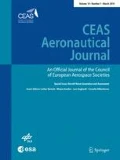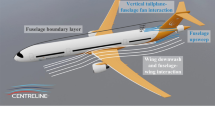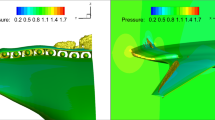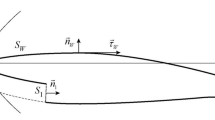Abstract
Breaking with the classical separation of airframe and power plant system, new synergy effects may be rooted in close design coupling and the approach of distributing the production of thrust along the main components of the airframe. Beside greater configurational flexibility, airframe structural relief, improved noise shielding, and, the potential for control power augmentation, distributed propulsion is particularly interesting due to the reduced propulsive power demands expected from the notion of aircraft wake filling. In previous work, the concept of a propulsor encircling the aft fuselage with intent to entrain the fuselage boundary layer was identified to be one of the most promising concepts for aircraft wake filling. In this paper, the analytical basis for the quantification of efficiency benefits connected to the propulsive fuselage concept is discussed. Appropriate control volume and consistent efficiency chain definitions are introduced. A simplified boundary layer model is derived from axisymmetric fuselage CFD simulation and used to determine the momentum deficit ingested by the fuselage propulsor. Based on a novel figure of merit for vehicular efficiency, the energy-specific air range, ESAR, the dependency of aircraft cruise efficiency on basic propulsion system and aircraft design changes is parametrically investigated. Specifically, the sensitivities of vehicular efficiency w.r.t. wing aspect ratio and flow transition characteristics, propulsor size, and aircraft design cruise Mach number are studied.









Similar content being viewed by others
Abbreviations
- BLI:
-
Boundary layer ingestion
- CFD:
-
Computational fluid dynamics
- CFRP:
-
Carbon fibre-reinforced polymers
- EIS:
-
Entry-into-service
- ESAR:
-
Energy-specific air range
- FPR:
-
Fan pressure ratio
- GTF:
-
Geared turbofan
- HPT:
-
High-pressure turbine
- LPT:
-
Low-Pressure Turbine
- LTH:
-
Luftfahrttechnisches handbuch
- MAC:
-
Mean aerodynamic chord
- MTOW:
-
Maximum take-off weight
- OEW:
-
Operating empty weight
- OPR:
-
Overall pressure ratio
- PSC:
-
Power-saving coefficient
- SAR:
-
Specific air range
- TOC:
-
Top-of-climb
- TSFC:
-
Thrust-specific fuel consumption
- TSPC:
-
Thrust-specific power consumption
- D :
-
[N] Drag
- F :
-
[N] Thrust
- h :
-
[m] Duct height
- L :
-
[N] Lift
- m :
-
[kg] Mass
- M :
-
[–] Mach number
- p :
-
[N/m2] Pressure
- P :
-
[W] Power
- Re :
-
[–] Reynolds number
- S :
-
[m2] Wing area
- V :
-
[m/s] Velocity
- x :
-
[m] Fuselage axial coordinate
- β :
-
[–] Ingested drag ratio
- γ:
-
[–] Isentropic exponent
- δ :
-
[–] Boundary layer thickness
- η :
-
[–] Efficiency
- φ :
-
[rad] Sweep angle
- *:
-
Boundary layer ingestion case
- 0:
-
Ambient conditions, free stream
- 1:
-
Propulsion system intake
- 2:
-
Fan inlet
- A/C:
-
Aircraft
- D0:
-
Zero-lift drag
- ec:
-
Energy conversion
- ing:
-
Ingested
- LE:
-
Leading edge
- m:
-
Area-averaged mean
- N:
-
Net
- ov:
-
Overall
- pd:
-
Propulsive device
- pr:
-
Propulsive
- ref:
-
Reference
- rel:
-
Relative
- t:
-
Total
- T:
-
Transition
- tr:
-
Transmission
References
European Commission, Flightpath 2050: Europe’s Vision for Aviation, (2011)
Advisory Council for Aviation Research and Innovation in Europe: Strategic Research and Innovation Agenda, (2012)
Wilfert, G.: NEW Aero engine Core concepts (NEWAC). FP6-2005-Aero-1, Contract No. AIP5-CT-2006-030876, European Commission Directorate General for Research and Innovation, (2006)
von der Bank, R.: Low EMissions COre-Engine TEChnologies (LEMCOTEC). FP7-AAT-2011-RTD-1, Proposal No. 283216, European Commission Directorate General for Research and Innovation, (2010)
Sendrane, H.: Engine BREAK-through components and sub-systems (E-BREAK). FP7-AAT-2012-RTD-1, Proposal No. 314366, European Commission Directorate General for Research and Innovation, (2011)
Korsia, J.-J.: Environmentally Friendly Aero-Engine (VITAL). Contract No. AIP4-CT-2004-012271, European Commission Directorate General for Research and Innovation, (2005)
Bone, D.: valiDation of Radical Engine Architecture systeMs (DREAM). FP7-AAT-2007-RTD-1, Proposal No. 211861, European Commission Directorate General for Research and Innovation, (2008)
Isikveren, A.T., Sizmann, A., Hornung, M.: Realising Flightpath 2050: Initial Investigation of Potential Technological Solutions. SAE 2011 AeroTech Congress and Exhibition, Toulouse, France, 11ATC-0562, (2011)
Kim H.D.: Distributed propulsion vehicles, In 27th International Congress of the Aeronautical Sciences (ICAS), (2010)
Steiner,H., Seitz, A., Wieczorek, K., Plötner, K., Isikveren, A. T., Hornung, M.: Multi-disciplinary design and feasibility study of distributed propulsion systems, In 28th International Congress of the Aeronautical Sciences (ICAS), (2012)
Isikveren, A.T.: (coordinator), Distributed Propulsion and Ultra-high By-pass Rotor Study at Aircraft Level (DisPURSAL). FP7-AAT-2012-RTD-L0, Proposal No. 323013, European Commission Directorate General for Research and Innovation, (2012)
Stückl, S., van Toor, J., Lobentanzer, H.: VoltAir–The All Electric Propulsion Concept Platform–A Vision for Atmospheric Friendly Flight, In 28th International Congress of the Aeronautical Sciences (ICAS), (2012)
Bolonkin, A.: A high efficiency fuselage propeller (‘Fusefan’) for subsonic aircraft. World Aviation Conference, San Francisco (1999)
Seitz, A.: Advanced methods for propulsion system integration in aircraft conceptual design, PhD Dissertation, Institut für Luft- und Raumfahrt, Technische Universität München, (2012)
Performance prediction and simulation of gas turbine engine operation for aircraft, marine, vehicular, and power generation. Final Report of the RTO Applied Vehicle Technology Panel (AVT) Task Group AVT-036, North Atlantic Treaty Organisation (NATO), (2007). TR-AVT-036
Seitz, A., Schmitz, O., Isikveren, A.T., Hornung, M.: Electrically Powered Propulsion: Comparison and Contrast to Gas Turbines, Paper No. 1358, Deutscher Luft- und Raumfahrtkongress 2012, Berlin, September (2012)
Seitz, A., Isikveren, A.T., Hornung, M.: Pre-Concept Performance Investigation of Electrically Powered Aero-Propulsion Systems, AIAA-2013-3608, presented at 49th AIAA/ASME/SAE/ASEE Joint Propulsion Conference and Exhibit, San José, CA, USA, 14–17 July, (2013)
Smith, L.H. Jr: Wake ingestion propulsion benefit. J Propul Power 9, 74–82 (1993)
Torenbeek, E.: Synthesis of subsonic airplane design. Kluver Academic Publishers, London (1982)
Gur, O., Mason, W., Schetz, J.: Full configuration drag estimation. AIAA 2009-4109, In 27th AIAA Applied Aerodynamics Conference, San Antonio, Texas, 22–25 June. American Institute of Aeronautics and Astronautics, Inc., 2009
Luftfahrttechnisches Handbuch. http://www.lth-online.de (2006)
Seywald, K.: Wingbox Mass Prediction considering Quasi-Static Nonlinear Aeroelasticity, Diploma Thesis, Technische Universität München, (2011)
Eisenbarth, D.: Elastic Instability Analysis and Integration for a Non-Linear Structural Design Tool, Term Paper, Technische Universität München, (2013)
Raymer, D.: Aircraft design: a conceptual approach, 4th edn. AIAA Education Series. American Institute of Aeronautics and Astronautics Inc, New York (2006)
Hepperle, M.:MDO of Forward Swept Wings, KATnet II Workshop, 28–29 January 2008, Braunschweig
Kurzke, J.: Gasturb11, Compiled with Delphi 2007 on 27 January, (2010)
Grieb, H., Schubert, H. (eds.): Projektierung von TurboflugtriebwerkenBirkhäuser Verlag, Basel-Boston-Berlin, (2004)
Reynolds, C.: Advanced Propfan Engine Technology (APET) Single- and Counterrotation Gearbox/Pitch Change Mechanism, Final Report, Pratt & Whitney United Technologies Corporation, NASA-CR-168114, 1 & 2, (1985)
Van Dyck, L.: Design study of a boundary layer ingesting Propulsive Fuselage concept. Master’s thesis, Delft University of Technology, (2012)
Schlichting, H., Gersten, K.: Grenzschicht-Theorie. Springer, New York (2006)
Acknowledgments
The authors would like to thank Julian Bijewitz and Clément Pornet for their support in reference engine and aircraft modelling, respectively, as well as, Askin Isikveren and Sascha Kaiser for fruitful technical discussions. In particular, the authors would like to thank Hans-Jörg Steiner for his preceding research on distributed propulsion at Bauhaus Luftfahrt and valuable advice during the preparation of this paper. This research was conducted within the FP7-L0 project DisPURSAL (Grant Agreement No. FP7-323013), co-funded by the European Commission.
Author information
Authors and Affiliations
Corresponding author
Additional information
This paper is based on a presentation at the CEAS Air and Space Conference 2013, September 16–19, Linköping, Sweden.
Rights and permissions
About this article
Cite this article
Seitz, A., Gologan, C. Parametric design studies for propulsive fuselage aircraft concepts. CEAS Aeronaut J 6, 69–82 (2015). https://doi.org/10.1007/s13272-014-0130-3
Received:
Revised:
Accepted:
Published:
Issue Date:
DOI: https://doi.org/10.1007/s13272-014-0130-3




